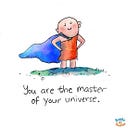The Benefits of Blurry Vision
Buddhist thought, glasses, and accepting reality
I learned I had blurry vision in Egypt. I was 28. Once fitted with my goggles, I looked in disbelief. This whole burger-flipping time! I didn’t know I needed glasses, until I got glasses.
I had the perfect prescription: -0.75 and -1.25. The golden ratio.
Enough to affect reality in a subtle, almost pleasing way (think the smoothing tool in Photoshop). But not enough to notice, or be in danger from oncoming traffic.
I’ll get to the point.
Blurry vision diminishes passion to forms and allows us to see reality closer to what it really is like. If you look through a microscope you will see amoebas and small shapes — still with distinct forms. But when you get to the particle level, everything is blurry.
Quantum physics shows electrons in a flux between form and wave, and uncertainty within every phenomena. At this resolution, reality is not defined as it seems while using our sense of sight.
Regarding passion
Without spectacles I mistake genders at 25 metre distances. I mix up faces — people are hard to recognize. Beauty takes on new meaning.
Why is this good?
Reacting to physical forms with anger, passion, aversion, or craving is hardwired into our system. We depend on sight for survival. Snake = fear; spaghetti = yum; abusive person = anger, fear, resentment, sympathy?
This code in our DNA is ruthless, a bit blunt, and heritage from our evolutionary past. With blurry vision, I get passionate hormone responses from what I think is a beautiful figure, only to find an old women, or even a man (I am a heterosexual male).
What am I mostly attracted to? Fertility. That is how our genes reproduce. When I see figures with certain proportions, I might be aroused or deflated.
Sorry to disappoint the love-at-first-sight-soul-mate-happily-ever-after conditioning. We were monkeys longer than humans. That’s not to say everyone is obsessed with only reproduction. The human side of us has an ability to override and transcend urges — to abstain, be spiritual, to have culture, to build community.
It takes effort to try and see through forms and be with someone for who they are.
This hardware issue (our instinctive reactions to forms) can act as a glitch in the matrix. An opportunity to see things as they really are. An opportunity to see the three core characteristics of all phenomena:
1. Impermanence
2. Non self
3. Suffering.
We are excited by forms, which turns into craving, then attachment, agitation, and ultimately: suffering. At a particle/quantum level everything is undergoing constant change. Even you! Yes. You are vibrating, oscillating, and decaying as we speak. All in a flux, all in a flow.
Change
But we cannot perceive this subtle (almost oppressive) change, because we have not developed our faculty of awareness to that resolution (but we can). So we delude ourselves into thinking 1. forms are permanent. 2. We — ourselves — are continuous from birth to death. And, 3. There is some innate pleasure to be found in this sea of moving-shaking-breaking — in this blurry world.
So there are three main delusions: Continuity, compactness (permanence in form), and contentment (with material reality).
This is similar to the buddha’s teachings.
In meditation we are taught to tune our awareness down to the particle level and witness change — without judgment.
If you close your eyes, and feel the sensations in you hands … what is that? … Tingling? Nerve impulses? Circulation? Electromagnetic reactions?
Change.
Yes, you just felt the changing nature of reality. We can experience it! Now imagine your mind was not completely distracted and out of control, and you cultivated this awareness spending hours scanning your body, and witnessing change. What would that do to your perspective on life, love, and mundane career aspirations?
If we are just a network of body-mind-action-reactions, what does that mean for our notion of self?
Anyways, this takes practice and the occasional removal from mainline society (stimulation reduction). This is why some humans become monks and nuns.
Back to glasses.
When we see the world as a blurry, it is actually closer to reality — moving, shaking, and constantly changing.
So take off your spectacles, and questions the forms which you hold so dear.
A side story:
A friend of mind in Seoul has a -11, -14 prescription. Everything is fuzzy geometric shapes without his specs.
He is in danger without them.
He tells me that not reacting to eyes and faces allows him to cue in on other markers (sounds, smell, etc.). And just reacting to basic geometrical shapes, especially feet, has heightened his spatial awareness — giving him a small superpower even when he has his glasses on.
hmmm.
